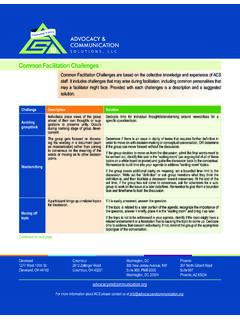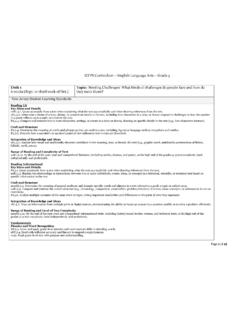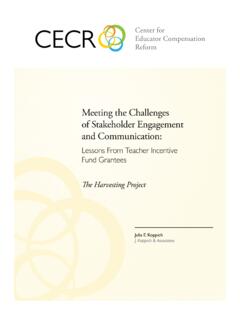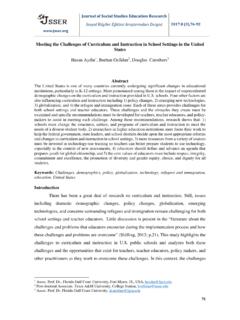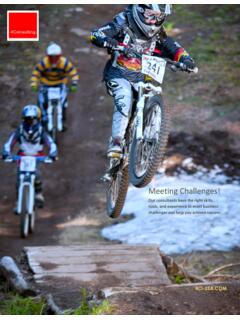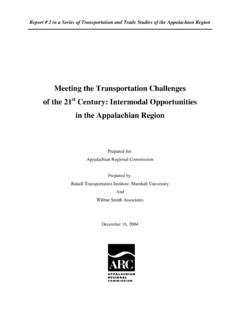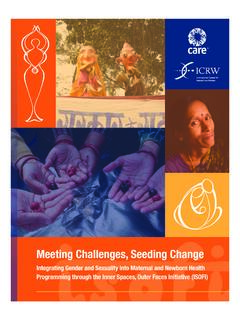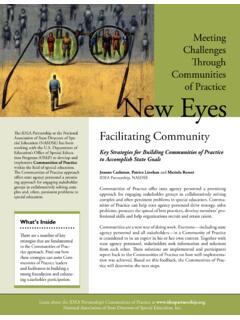Transcription of Meeting the challenges of an aging population with success
1 /KirwanInstitute | Meeting the challenges of an aging population with successCOLLEGE OF SOCIAL WORKS enior Advisory BoardLeslie Belfance Executive Director, Westminster-Thurber CommunityToni Carroll, MA, LSW Director, Franklin County Office on AgingJeffrey Caterino, MD, MPH Associate Professor of Emergency Medicine and Internal Medicine, Director of Clinical Research for the Department of Emergency Medicine, The Ohio State University Erica Drewry Board of Directors, National Church ResidencesCindy Farson Director, Central Ohio Area Agency on AgingJohn Gregory, MSW, LSW Senior Vice President of Operations, LifeCare AllianceMary Beth Happ, PhD, RN, FAAN Distinguished Professor of Critical Care Research; Director, Center of Excellence in Critical and Complex Care, The Ohio State UniversityAnnette Jefferson Private Caregiver of Ohio Humanities Authors and ContributorsMatt Martin Senior Researcher, The Kirwan Institute for the Study of Race and EthnicityChristy Rogers, PhD Director of Outreach, The Kirwan Institute for the Study of Race and EthnicityHolly Dabelko-Schoeny, PhD Associate Professor, College of Social Work, The Ohio State UniversityKeith Anderson, PhD Associate Professor, College of Social Work, The Ohio State UniversityGlennon Sweeney Research Associate, The Kirwan Institute for the Study of Race and EthnicityYumi Choi Graduate Research Associate.
2 The Kirwan Institute for the Study of Race and EthnicityDesign Jason Duffield Web/Graphic Communications Specialist, The Kirwan Institute for the Study of Race and EthnicitySenior Study IntervieweesSpecial Thanks To:Jeff Althouse Senior Center Manager, Westerville Senior CenterKarin Blythe Senior Program Manager, Community Refugee and Immigration Services WithWaleed Eade Case Worker, Senior Services, Community Refugee and Immigration ServicesMekonnen Gemeda Case Worker, Senior Services, Community Refugee and Immigration ServicesLaden Jama Case Worker, Senior Services, Community Refugee and Immigration ServicesNetra Mishra Case Worker, Senior Services, Community Refugee and Immigration ServicesOm Subedi Case Worker, Senior Services, Community Refuge and Immigration ServicesEyassu Yeshak Case Worker, Senior Services, Community Refugee and Immigration ServicesLouis M.
3 Borowicz ESQ Partner, Baxter & Borowicz Co. LPAB onnie Burman, ScD Director, Ohio Department of aging Hollie Goldberg, LISW-S Director of Older Adult Services/Quality Improvement, Syntero WithMaxine Golgoff Social Worker, SynteroRich Hagopian Pastor, Smoky Row Brethren ChurchWithAnna Moreno Director of Smoky Row Brethren Food PantryLinda Mauger Program Director, Office of Geriatrics and Gerontology, The Ohio State UniversityLeon McDougle, MD Associate Professor of Family Medicine, Associate Dean for Diversity and Cultural Affairs, and Chief Diversity Officer at The Ohio State University; Lead Physician-Research at OSU Family Medicine at CarePoint East, The Ohio State University Medical Center Bill Owens, LISW-S/ACSW Executive Director, Clintonville-Beechwold Community Resource Center WithLiz Harzoff Case Worker, Clintonville-Beechwold Community Resource CenterLarke Recchie Chief Executive Officer, Ohio Association of Area Agencies on AgingAmanda Ripkey, LISW Home Based Primary Care Social Worker, Columbus Veterans Affairs Michele Stokes Director of Senior Health Services/Gerlach Center for Senior Health, OhioHealthMeg Teaford, PhD Associate Clinical Professor, The Ohio State University School of Health and Rehabilitation SciencesCarol Ventreska, PhD Executive Director, Employment For Seniors, Inc.
4 Julie Wise Senior Services Director, St. Stephen s Community House Jeff Young Fire Chief, City of Upper Arlington, STAY UAWith:Christine Leyshone STAY UA Service Coordinator, City of Upper Arlington, STAY UALyn Nofzinger EMS and Training Captain, City of Upper Arlington, STAY UAPREFACEN ever before have we, as a society, seen such long lifespans for such a large number of people. Never before have we, as a community, had to grapple with the opportunities and challenges presented by living in a community with so many aging family members. Living longer can be a blessing and a gift. It can be a challenge, particularly when one faces poverty, housing insecurity, disability, or isolation. Vulnerable seniors typically do not face a single difficulty, but compound-ed challenges .
5 No longer able to drive, yet unfamiliar with public transportation, an older adult might put off a doctor s appointment, or avoid grocery shopping. The high cost of medication for serious health issues might result in the non-payment of heat or phone bills. Seniors facing grave health concerns (and their families and caregivers) can struggle with nearly unmanageable costs, in terms of dollars, effort, and spirit. At the individual and family level, the challenges associated with aging limited mobility within and outside the home, perhaps an unwanted loss of work, and fewer civic and social responsibilities are the reality for many. Despite these challenges , and the growing number of older adults who face them, senior vulnera-bility and insecurity are largely ignored in many research, funding, and policy circles.
6 One of the most unjust challenges is that not every senior will live a significantly longer life. Nationally, there are marked differences in life expectancy by race, ethnicity, gender, geography, and income. This report reveals that, here in Franklin County, there is a nearly twenty-year difference in life expec-tancy for seniors living in different neighborhoods. There is no more fundamental improvement that one could make in the lives of older adults than to close this indeed, this is possible. There are extraordinary resources here in Franklin County Univer-sities and Colleges, research institutes, health-care systems, settlement houses, and seniors and their advocates. There are people, programs and services available for seniors in need, at the state, national, and local level.
7 There are passionate, hard-working, creative, and inspired senior care-givers, service providers, and researchers. The people who care for, research, and serve seniors have begun to pioneer innovations, not only in terms of services and programming, but in terms of changing the narrative around vulnerable older new narrative is that vulnerable older adults may face a myriad of challenges , but they should not be undervalued or underestimated. It is that no one should be ashamed to ask for help; we all, at some point in our lives, need help. It is that earlier interventions and forward planning can help families cope emotionally and financially when hard changes begin to happen, prior to reaching a crisis point. It is that if we work together, we can chart a new course, one where older adults are included in decision-making around their own lives, where service and health care professionals have the tools they need to attend to older adults particular needs, and where we no longer seg-regate our older adults from the vibrant community life that helps sustain mind, body and is this new narrative that can help shape our collective path forward, because there are no weath-ered signposts.
8 The recognition that we are in largely uncharted waters, and the extent of senior vulnerability described in this report, can feel overwhelming. We are attempting to care for a demo-graphic cohort that has simply never existed before. Our academic collaborators from the College of Social Work preferred innovative practices to best practices, because there are so few longi-tudinal, rigorously evaluated studies to rely on. We do not have decades of experience caring for adults over age 65, or 75, or 85, because we have only begun to explore and understand the contri-butions and needs of our oldest community members. But with every complex and unsolved challenge, there exists an enormous opportunity to lead, to learn, and to contribute to meaningful improvements and innovative solutions.
9 Community leaders and senior service stakeholders can make a difference in any number of ways from sup-portive to transformative. Promote rigorous evaluations of pilot programs. Provide more accessible, affordable housing. Make a neighborhood-focused investment in one of our highest-need areas. Support caregivers. Expand settlement house programming. Help seniors enter and navigate ex-isting services. Issue a bold challenge to face the injustice of segregated longevity. Seed fund a competitive prize for transportation innovation. Lead the conversation around older adults, with older adults, with urgency and commitment. We provide recommendations such as these, but we also provide the descriptive information, guiding principles, key findings, and most promising in-novative practices for our seniors, so that community leadership can collaboratively design their own transformative interventions.
10 One powerful analytic and communications tool developed specifically for this report is the Senior Vulnerability and Density index and corresponding map. Our partners at the College of Social Work compiled a set of research-based indicators of senior vulnerability, such as housing cost burden, disability, and limited education. Twelve indicators of vulnerability were then confirmed by our conversations with local practitioners, and combined into an overall index of vulnerability, ranging from low to high. This conceptually addresses the existence of cumulative disadvantage: extreme vulnerability rarely manifests as a single or siloed issue. Next, we mapped senior density across the county to find neighborhoods with high concentrations of seniors.
